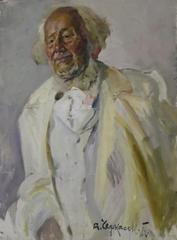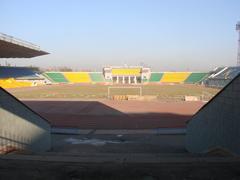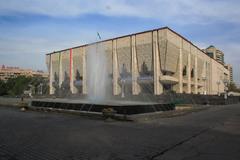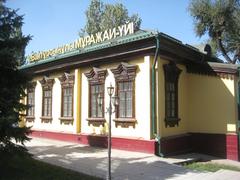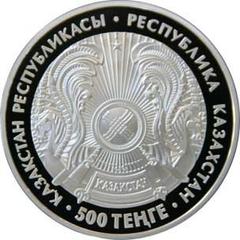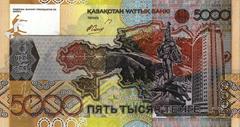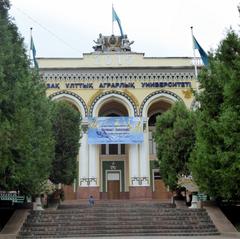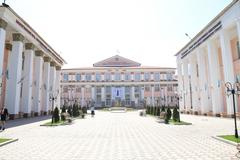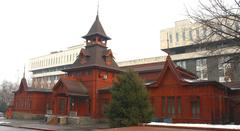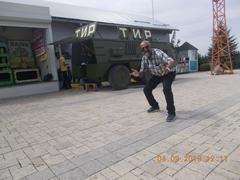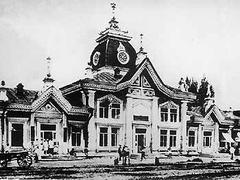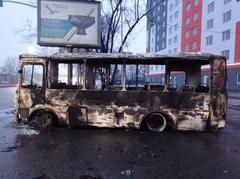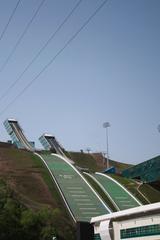Moskva, Almaty, Kazakhstan: Visiting Hours, Tickets, and Historical Sites Guide
Date: 04/07/2025
Introduction
Moskva, a vibrant microdistrict in Almaty, Kazakhstan, offers visitors a compelling mix of Soviet-era heritage and contemporary urban life. Named in honor of Russia’s capital, the area is a living symbol of the enduring historical, cultural, and economic ties between Kazakhstan and Russia (The Diplomat in Spain). Unlike typical tourist destinations with strict operating hours and ticketed attractions, Moskva is primarily a residential and commercial area, allowing travelers to immerse themselves in authentic local experiences, explore significant landmarks, and access outstanding citywide amenities (orexca.com).
This guide provides a detailed overview of Moskva’s history, architectural character, cultural significance, and practical tips for visitors—including how to get there, what to see and do, nearby attractions, and essential travel advice. Whether you are interested in Soviet architecture, Kazakh culture, culinary adventures, or simply a genuine slice of local life, Moskva stands out as an essential destination within Kazakhstan’s largest city (audiala.com).
Table of Contents
- Historical Background of Moskva, Almaty
- Cultural Significance and Local Life
- Architectural Features and Urban Landscape
- Practical Visitor Tips
- Cultural Experiences and Events
- Main Attractions and Visiting Hours
- Dining and Nightlife
- Nearby Attractions
- Accommodation Options
- Seasonal Considerations
- Frequently Asked Questions (FAQ)
- Final Tips and Recommendations
- References
Historical Background of Moskva, Almaty
The Moskva microdistrict exemplifies the Soviet tradition of naming urban neighborhoods after prominent cities, reflecting the deep-rooted influence of Russian culture and politics in Kazakhstan. Established during the expansion of Almaty in the 20th century, Moskva was designed as a communal living space, with standardized apartments, green courtyards, and essential services to accommodate the city’s growing workforce (orexca.com). Following Kazakhstan’s independence in 1991, Moskva evolved, blending Soviet-era elements with the energy of a modern metropolis.
Almaty itself, once Kazakhstan’s capital, boasts a history linked to the Silk Road and serves as a cultural crossroads. The Moskva district embodies this transformation, standing at the intersection of historical legacy and contemporary urban development.
Cultural Significance and Local Life
Moskva is a microcosm of Almaty’s multicultural identity. It is home to a diverse population, including Kazakhs, Russians, Uzbeks, Uyghurs, and more (education.stateuniversity.com). The neighborhood’s communal design fosters social interaction, with shared courtyards, local bazaars, and parks where residents gather. Culinary diversity abounds, with traditional Kazakh dishes like beshbarmak and Russian favorites such as borscht widely available (mywanderlust.pl). Religious tolerance is evident, with mosques and Orthodox churches situated nearby.
The district’s ongoing modernization is visible in the emergence of new residential complexes, shopping centers, and cafes, reflecting Kazakhstan’s economic growth and openness to global influences (kazakhstan-tourism.com).
Architectural Features and Urban Landscape
Moskva’s architecture is dominated by Soviet-style panel buildings—khrushchyovkas and brezhnevkas—characterized by their functional, uniform design (orexca.com). Many of these buildings have been renovated, while others still display their original facades, offering a window into Almaty’s past.
Well-maintained parks, tree-lined avenues, and playgrounds provide green spaces for relaxation. The district is self-sufficient, with amenities such as schools, clinics, and supermarkets within walking distance. Recent commercial developments include modern malls and fitness centers, catering to a growing, diverse population. Public art and murals celebrating Kazakh heritage and multiculturalism further enrich the urban landscape.
Practical Visitor Tips
Getting There and Around
Moskva is easily accessible from central Almaty by metro (Moskva Metro Station—Green Line), bus, or taxi (exploretraveloasis.com). The metro operates daily from 6:20 AM to midnight; tickets cost about 80 KZT (~$0.20 USD), available at station kiosks and machines. Yandex Go and inDriver are the most reliable ride-hailing apps, while local buses and trolleybuses connect Moskva to major city attractions.
Bicycle rentals and pedestrian-friendly streets make walking and cycling pleasant, especially in spring and autumn (touristplaces.guide).
Safety and Etiquette
Almaty is generally safe, including the Moskva district. Exercise standard precautions—secure valuables, avoid isolated areas at night, and be aware of your surroundings. Modest dress is appreciated in religious sites. English is less common outside tourist areas, so basic Russian or Kazakh phrases can be helpful (niv.travel).
Local Amenities and Services
Moskva offers supermarkets, pharmacies, ATMs, and numerous cafes. Local canteens (stolovayas) provide affordable, authentic meals. Wi-Fi is widely available in cafes and public spaces. Healthcare is accessible, but travelers should bring essential medications, as brand names may differ.
Cultural Experiences and Events
Moskva itself does not host major tourist events, but its central location provides easy access to Almaty’s rich cultural calendar. Annual celebrations like Nauryz (Persian New Year, March) bring music, dance, and traditional cuisine to the city (orexca.com). Community centers and parks occasionally feature concerts and exhibitions.
Guided tours to ethnographic villages or yurt camps can be arranged from Almaty, offering immersive experiences of Kazakh traditions (mywanderlust.pl).
Main Attractions and Visiting Hours
Moskva Shopping Mall
A key commercial hub, the Moskva Shopping Mall features over 100 stores, a modern cinema, food court, and entertainment zones.
- Visiting Hours: 10:00–22:00 daily
- Entry: Free; cinema tickets vary by show
- Facilities: Free Wi-Fi, ATMs, currency exchange, play areas, parking
- Accessibility: Wheelchair-friendly; multilingual information desks
Moskva Monument
A landmark symbolizing the friendship between Almaty and Moscow, the Moskva monument is located in the heart of the district.
- Open Access: 24/7; guided tours run 10:00–18:00 (fee: ~1000 KZT)
- Photography: Excellent at sunrise and sunset
- Accessibility: Wheelchair-friendly
Nearby Historical Sites
- Ascension Cathedral (Zenkov Cathedral): 9:00–19:00, free entry
- Green Bazaar: 7:00–19:00, free entry
- Kok-Tobe Hill (cable car): 10:00–22:00, ~1500 KZT round trip
- Medeu Ice Rink: October–April, 10:00–22:00, ~1000 KZT entry
Dining and Nightlife
Moskva boasts an eclectic dining scene with Kazakh, Russian, Central Asian, and international cuisines. Average meal costs range from $5–$20 (audiala.com). Try traditional drinks like kumis or shubat for an authentic local experience.
Nightlife includes bars, lounges, and nightclubs, many with live music and DJs. Yandex Go is recommended for safe late-night transport.
Nearby Attractions
- Panfilov Park & Zenkov Cathedral: Iconic wooden cathedral and WWII memorials
- Green Bazaar: Central market with local goods
- Kok-Tobe Hill: Panoramic city and mountain views
- Medeu Ice Rink & Shymbulak Ski Resort: Popular for winter sports
- Central State Museum & Kasteyev State Museum of Arts: Rich in Kazakh history and art
Accommodation Options
Moskva and its surroundings offer a range of accommodations:
- Luxury: The Ritz-Carlton, The Dostyk Hotel
- Mid-range: Renion Park Hotel, Kazakhstan Hotel
- Budget: D’Rami Hotel, local hostels
- Apartments: Serviced apartments for longer stays
Prices range from $10 (hostels) to $100+ (luxury hotels) per night (therovingheart.com).
Seasonal Considerations
Almaty’s continental climate brings four distinct seasons (Best Time To Visit Almaty):
- Spring (April–June): Pleasant, blooming parks
- Summer (June–September): Warm, ideal for city exploration
- Autumn (September–November): Mild, with colorful foliage
- Winter (December–February): Cold, popular for winter sports
Spring and autumn are best for sightseeing. Book accommodations early during festivals.
Frequently Asked Questions (FAQ)
Q: Are there set visiting hours or ticket prices for Moskva?
A: Moskva is a residential and commercial district, open at all hours. Key attractions like the shopping mall and monument have specified hours.
Q: How do I get around Moskva and Almaty?
A: Metro, buses, and ride-hailing apps are efficient and affordable.
Q: Is Moskva accessible for people with disabilities?
A: Most modern facilities and the metro are wheelchair-accessible.
Q: What languages are spoken?
A: Russian and Kazakh are primary; English is used in major hotels and malls.
Q: What is the best time to visit Moskva?
A: Spring and autumn for mild weather; winter for snow sports.
Final Tips and Recommendations
- Use Yandex Go or inDriver for taxis.
- Exchange some cash for small purchases.
- Try local dishes at cafeterias and canteens.
- Respect local customs, especially in religious and communal spaces.
- Download navigation and translation apps for convenience.
For more insights and up-to-date recommendations, consult the Almaty Tourism Board, audiala.com, and consider downloading the Audiala app.
